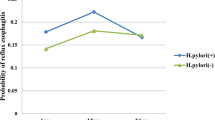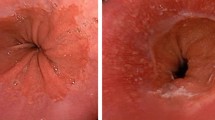Abstract
Background
Despite low gastric acid secretion levels among elderly people and Helicobacter pylori-positive individuals in Japan, many patients suffer from endoscopic relapse of erosive gastroesophageal reflux disease (GERD) during standard-dose proton pump inhibitor (PPI) maintenance therapy. We aimed to investigate the relapse rate and risk factors for relapse during long-term PPI therapy in a prospective multicenter study.
Methods
Patients diagnosed endoscopically as having erosive GERD according to the Los Angeles (LA) classification, with remission under PPI medication, and without mucosal damage in the esophagus, were enrolled and took rabeprazole 10 mg/day, the standard dose in Japan, for up to 104 weeks, with endoscopy at weeks 24, 52, 76, and 104; erosive GERD with LA classification grade A, B, C, or D was defined as relapse.
Results
The baseline status of the 191 cases analyzed was: female (34.6%), ≥65 years old (50.8%), H. pylori-positive (40.8%), body mass index (BMI) ≥25 kg/m2 (35.6%), and hiatus hernia (79.6%). Relapse occurred by week 104 in 21 cases (11%; 12 females, 9 males). Risk factors were hiatus hernia; severe past erosive GERD (grade C or D); H. pylori-negative; no mucosal atrophy; nonsmoking; and being female and <150 cm in height.
Conclusions
This study revealed the significant risk factors that might be monitored during long-term maintenance therapy to prevent relapse of GERD.


Similar content being viewed by others
References
Kinoshita Y, Kawanami C, Kishi K, Nakata H, Seino Y, Chiba T. Helicobacter pylori independent chronological change in gastric acid secretion in the Japanese. Gut. 1997;41:452–8.
Miyamoto M, Haruma K, Kuwabara M, Nagano M, Okamoto T, Tanaka M. High incidence of newly developed gastroesophageal reflux disease in the Japanese community: a 6-year follow-up study. J Gastroenterol Hepatol. 2008;23:393–7.
Collen MJ, Johnson DA, Sheridan MJ. Basal acid output and gastric acid hypersecretion in gastroesophageal reflux disease. Correlation with ranitidine therapy. Dig Dis Sci. 1994;39:410–7.
Collen MJ, Strong RM. Comparison of omeprazole and ranitidine in treatment of refractory gastroesophageal reflux disease in patients with gastric acid hypersecretion. Dig Dis Sci. 1992;37:897–903.
Bell NJ, Burget D, Howden CW, Wilkinson J, Hunt RH. Appropriate acid suppression for the management of gastro-oesophageal reflux disease. Digestion. 1992;51(Suppl 1):59–67.
Hatlebakk JG, Berstad A. Prognostic factors for relapse of reflux oesophagitis and symptoms during 12 months of therapy with lansoprazole. Aliment Pharmacol Ther. 1997;11:1093–9.
Carlsson R, Galmiche JP, Dent J, Lundell L, Frison L. Prognostic factors influencing relapse of oesophagitis during maintenance therapy with antisecretory drugs: a meta-analysis of long-term omeprazole trials. Aliment Pharmacol Ther. 1997;11:473–82.
Makuuchi H. Clinical study of esophageal hiatal hernia: diagnostic criteria and degree classification of hiatal hernia. Jpn J Gastroenterol. 1982;79:1557–66 (in Japanese with English abstract).
Kusano M, Hashizume K, Ehara Y, Shimoyama Y, Kawamura O, Mori M. Size of hiatus hernia correlates with severity of kyphosis, not with obesity, in elderly Japanese women. J Clin Gastroenterol. 2008;42(4):345–50.
Kimura K, Takemoto T. An endoscopic recognition of the atrophic border and its significance in chronic gastritis. Endoscopy. 1969;3:87–97.
Thjodleifsson B, Rindi G, Fiocca R, Humphries TJ, Morocutti A, Miller N, et al. A randomized, double-blind trial of the efficacy and safety of 10 or 20 mg rabeprazole compared with 20 mg omeprazole in the maintenance of gastro-oesophageal reflux disease over 5 years. Aliment Pharmacol Ther. 2003;17:343–51.
Caos A, Breiter J, Perdomo C, Barth J. Long-term prevention of erosive or ulcerative gastro-oesophageal reflux disease relapse with rabeprazole 10 or 20 mg vs. placebo: results of a 5-year study in the United States. Aliment Pharmacol Ther. 2005;22:193–202.
Emerenziani S, Habib FI, Ribolsi M, Caviglia R, Guarino MP, Petitti T, et al. Effect of hiatal hernia on proximal oesophageal acid clearance in gastro-oesophageal reflux disease patients. Aliment Pharmacol Ther. 2006;23:751–7.
Shimatani T, Moriwaki M, Xu J, Tazuma S, Inoue M. Acid-suppressive effects of rabeprazole: comparing 10 mg and 20 mg twice daily in Japanese Helicobacter pylori-negative and -positive CYP2C19 extensive metabolisers. Dig Liver Dis. 2006;38:802–8.
Yamaguchi K, Iwakiri R, Hara M, Kikkawa A, Fujise T, Ootani H, et al. Reflux esophagitis and Helicobacter pylori infection in patients with scleroderma. Intern Med. 2008;47:1555–9.
Iwakiri R, Fujimoto K. Importance of vertebral fracture and body mass index in the pathogenesis of gastroesophageal reflux disease. Intern Med. 2008;47:1551–3.
Acknowledgments
We would like to thank five members of the staff of Eisai Co., Ltd. (Yasuhiro Marukawa, Toshihisa Arai, Kazutaka Matsuo, Toshiyuki Tamai, and Yukinori Sakata) for their kind assistance in preparing the manuscript.
Conflict of interest statement
This study was funded by Eisai Co., Ltd. Kazuma Fujimoto and Michio Hongo are members of advisory committees of Eisai Co., Ltd.
Author information
Authors and Affiliations
Consortia
Corresponding author
Additional information
Members of the Maintenance Study Group are listed in the Appendix.
Appendix: Members of the Maintenance Study Group
Appendix: Members of the Maintenance Study Group
Tsuyoshi Yabana and Takeaki Kobayashi, Doto Hospital, Sapporo, Japan; Masashi Nomura, Masafumi Yoshida, Shinya Mitsui, and Akio Katanuma, Teine Keijinkai Hospital, Sapporo, Japan; Masafumi Komatsu and Akira Zeniya, Akita City Hospital, Akita, Japan; Kazutoshi Fukase, Katsuhiro Mabe, Chieko Kato, and Yasukuni Suzuki, Yamagata Prefectural Central Hospital, Yamagata, Japan; Yasutoshi Saito, Jizankai Medical Foundation Tsuboi Cancer Center Hospital, Koriyama, Japan; Nobuo Toda, Susumu Kurosawa, Rei Kashima, and Tetsuo Ebihara, Teikyo University Chiba Medical Center, Ichihara, Japan; Toshihide Maruyama, Juntendo University Urayasu Hospital, Urayasu, Japan; Ryoichi Wada, Tokuhisa Sezaki, and Nobuto Hirata, Kameda Medical Center, Kamogawa, Japan; Yasushi Kuyama, Taro Ishii, and Takatsugu Yamamoto, Teikyo University School of Medicine, Tokyo, Japan; Jun Miwa and Yasuo Matsubara, Toshiba General Hospital, Tokyo, Japan; Nobuyuki Matsuhashi, Yukihiro Sakurai, Masako Asayama, Koji Higa, and Tomohiko Hasue, Kanto Medical Center NTT EC, Tokyo, Japan; Hirokazu Komatsu, Kiyoko Imamura, Shigeru Yamanaka, Yoshio Hosaka, Yuriko Hara, and Shuichi Nagakubo, Yokohama Municipal Citizen’s Hospital, Yokohama, Japan; Sotaro Fujimoto, Hiromu Kutsumi, Nobuaki Yagi, and Masahiro Arai, Kyoto First Red Cross Hospital, Kyoto, Japan; Kenjiro Yasuda, Masatoshi Miyata, Munehiro Sakata, Moose Ueda, and Mami Ogawa, Kyoto Second Red Cross Hospital, Kyoto, Japan; Toshiki Takemura, Hideto Inokuchi, Masataka Matsushita, Kengo Takimoto, and Hideyuki Shiomi, Ijinkai Takeda General Hospital, Kyoto, Japan; Takama Maekawa, National Hospital Organization Kyoto Medical Center, Kyoto, Japan; Yukimasa Yamashita, Toko Kaneshiro, and Masamichi Nasu, Miki City Hospital, Miki, Japan; Kazuhiko Inoue and Osamu Mihara, Matsue Red Cross Hospital, Matsue, Japan; Shiro Okamoto and Kanji Kodama, Kure Kyosai Hospital, Kure, Japan; Toru Hidaka, Hiroshima City Asa Hospital, Hiroshima, Japan; Akira Tari and Hiroshi Tani, Hiroshima Red Cross Hospital & Atomic-Bomb Survivors Hospital, Hiroshima, Japan; Tomoki Inaba and Masaki Wato, Kagawa Prefectural Central Hospital, Takamatsu, Japan; Shuji Inoue, Sae Kujime, and Kozo Fuke, National Hospital Organization Kochi Hospital, Kochi, Japan; Masahito Nakauchi, Chiaki Watanabe,and Kazuo Nakajo, Jinsei-kai Hosogi Hospital, Kochi, Japan; Yozo Iida and Noboru Maetani, Kokura Memorial Hospital, Kitakyushu, Japan; Ryuichiro Maekawa, Shinichi Iwanaga, Masaru Sasaki, and Hajime Aino, Social Insurance Tagawa Hospital, Tagawa, Japan; Kazuma Fujimoto, Ryuichi Iwakiri, Hiroyuki Sakata, and Akifumi Ootani, Saga Medical School, Saga, Japan.
Rights and permissions
About this article
Cite this article
Fujimoto, K., Hongo, M. & The Maintenance Study Group. Risk factors for relapse of erosive GERD during long-term maintenance treatment with proton pump inhibitor: a prospective multicenter study in Japan. J Gastroenterol 45, 1193–1200 (2010). https://doi.org/10.1007/s00535-010-0276-7
Received:
Accepted:
Published:
Issue Date:
DOI: https://doi.org/10.1007/s00535-010-0276-7




